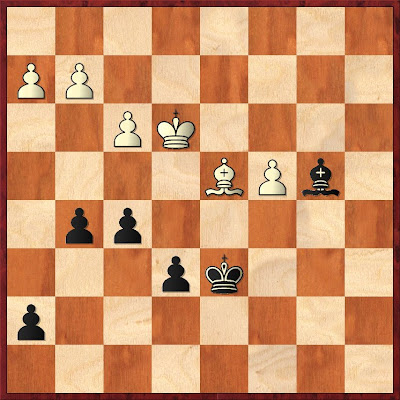Long-haired opponents are the most dangerous. They always want to attack, and they know the openings well. - Vlastmil Hort, 1975
I wrote about Tony Miles just
the other day. Just the week before, when I was composing the piece, I went to get my hair cut, at New Joan's in Huesca. I'm doing the same this morning, as it happens.
On the wall of the barber's is the poster depicted below.
I don't know exactly when it's from. in the UK I might guess "between the wars", but in Spain, for obvious reasons, that expression doesn't exist. As for the translation -
Jaque is "check", while
fijador is "gel", though I'm far from sure that people actually said "gel" back then.
Peinado means "cut" or maybe "styled", but do we, in fact, say "well cut" or "well styled" in English? Probably not. Perhaps "well turned out" might be an adequate translation.
Thinking of chess in conjunction with hair put me in mind of a celebrated spat towards the end of 1973 in the letters column of CHESS. This was kicked off by a letter in the October issue by one Stanley Lorley, who appeared to be attempting to win an award for the composition of the letter likely to be viewed by future generations as most completely and utterly wrong.
Extra points, surely, for invoking "politeness" while referring to people as "harlots" and "tramps". (We are most fortunate that bizarre misanthropic abuse is a thing of the past in chess publications.)
Back in 1973, however, it was apparently a different story. I don't know what the women so politely described as harlots thought about the letter - but as the November issue revealed, the tramps were very much not ashamed of themselves.
These days this would be a massive internet fight within minutes, but forty years ago one had to have a lot of patience to follow a flamewar, and it was not until December that a Leopold Winter fought back on behalf of the old age pensioners, issuing a challenge to the tramps to come and have a go if they thought they were hard enough.
Below Mr Winter's letter, however, was one from
Wolfgang Heidenfeld, which took a distinctly different point of view.
I don't have a subscription to CHESS these days (nor did I in 1973, thank you for asking) but I'd be impressed if today's letters were as entertaining as these. Still, being just as baffled by the modern world as Mr Lorley was in his day, I have no idea why these letters come out in different sizes.
Anyway, that seems to have been the end of the ruck, though on the subject of how-things-have-changed, I did see this letter in the issue for February 1974.
Obviously one hopes somebody was able to do something for Mr Jefcoate's friend, but what particularly struck me was the phrase
I wonder whether there has ever been an electronic push-button chess board
It surely can't be too long before younger chess players begin to ask, in connection with electronic push-button chessboards, whether there was ever any other kind.
But back to 1973. I trust Mister Lorley lived long enough to see England producing a number of players equal and even superior to George Thomas, a development about which he must have been decidedly ambivalent, given the length of many of these players' hair.
But what of Sir George, who died in 1972, the year before Mr Lorley wrote his letter invoking the late gentleman and Baronet?
His
Wikipedia entry includes the phrase "he never married", which might elevate some readers' eyebrows, given that it used to be obituarists' code for "gay". In point of fact, historiography doesn't appear to know whether or not George Thomas was gay, and quite likely, nowadays, most people couldn't care less either way. It wasn't like that forty years ago. I do find myself wondering what, if anything, his obituaries said in 1972. Or what Mr Lorley would have said.
[Poster: Recuerda Conmigo]
[Speelman image: Chess Analyses]




















































